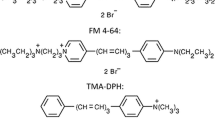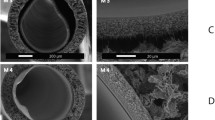Summary
Aminoethyl-Dextran T 10 (mol wt approx. 10,000) was conjugated withp-Chloromercuribenzoic acid (pCMB) and labeled with fluorescein isothiocyanate (FITC). This coupling procedure does not affect the mercurial function ofpCMB moiety of Fluorescent Mercury Dextran T 10 (FMD) since on the basis of mercury content itsK i-value for the (Na+−K+)-ATPase from rat kidney plasma membranes is identical with theK i -value of unconjugatedpCMB (3×10−6 m). FMD binds to plasma membranes if applied in vivo, which could be shown in experiments in which rat kidneys were perfused with FMD and the plasma membranes isolated after the perfusion. The membrane-FMD complex is stable during common isolation steps such as differential centrifugation, sucrose density gradient centrifugation and free-flow electrophoresis. This was shown by in vitro binding studies of FMD with isolated plasma membranes from rat kidney cortex. FMD may be removed from the plasma membranes by the addition of 1×10−4 m dithiotreitol. Since F-aminoethyl-Dextran T 10 (withoutpCMB) does not interact with the plasma membranes, it is suggested that the binding of FMD to plasma membranes may involve a Hg-SH reaction. FMD does not penetrate into rat kidney cells in contrast topCMB, but can cross capillaries. Thus, FMD seems to be suitable (a) to label luminal and contraluminal surfaces of plasma membranes of epithelial structures, and (b) to be used as a fluorescent marker for plasma membranes during succeeding isolation procedures.
Similar content being viewed by others
References
Bartlett, G. R. 1959. Phosphorus assay in colum chromatography.J. Biol. Chem. 234:466
Berg, H. C. 1969. Sulfanilic acid diazonium salt: A label for the outside of the human erythrocyte membrane.Biochim. Biophys. Acta 183:65
Bretscher, M. S. 1971. Human erythrocyte membranes: Specific labelling of surface proteins.J. Mol. Biol. 58:775
Bretscher, M. S. 1971. A major protein which spans the human erythrocyte membrane.J. Mol. Biol. 59:351
Carrol, N. V., Longly, R. W., Roe, J. H. 1956. The determination of glycogen in liver and muscle by use of anthrone reagent.J. Biol. Chem. 220:583
Eldjarn, L., Jellum, E. 1963. Organomercurial-polysaccharide, a chromatographic material for the separation and isolation of SH-proteins.Acta Chem. Scand. 17:2610
Fiske, C. H., Subbarow, Y. 1925. The colorimetric determination of phosphorus.J. Biol. Chem. 66:375
Habeeb, A. F. S. A. 1966. Determination of free amino groups in proteins by trinitrobenzenesulfonic acid.Analyt. Biochem. 14:328
Heidrich, H. G., Kinne, R., Kinne-Saffran, E. M., Hannig, K. 1972. The polarity of the proximal tubule cell in rat kidney. Different surface charges for the brushborder microvilli and plasma membranes from the basal infoldings.J. Cell Biol. 54:232
Himmelspach, K., Westphal, O., Teichman, B. 1971. Use of 1-(m-aminophenyl) flavazoles for the preparation of immunogens with oligosaccharide determinant groups.Europ. J. Immunol. 1:106
Hoelzl-Wallach, D. F. 1972. The dispositions of proteins in the plasma membranes of animal cells: Analytical approaches using controlled peptidolysis and protein labels.Review on Biomembranes (BBA) 265:61
Jørgensen, P. L. 1968. Regulation of the (Na++K+)-activated ATP hydrolyzing enzyme system in rat kidney. I. The effect of adrenalectomy and the supply of sodium on the enzyme system.Biochem. Biophys. Acta 151:212
Kinne, R., Kinne-Saffran, E. M. 1969. Isolierung und enzymatische Charakterisierung einer Bürstensaumfraktion der Rattenniere.Pflüg. Arch. Ges. Physiol. 308:1
Kinne, R., Schmitz, J. E., Kinne-Saffran, E. M. 1971. The localization of the Na+−K+-ATPase in the cells of rat kidney cortex. A study on isolated plasma membranes.Pflüg. Arch. Ges. Physiol. 329:191
Landon, E. J., Norris, J. L. 1963. Sodium- and potassium-dependent adenosine triphosphatase activity in a rat kidney endoplasmatic reticulum fraction.Biochim. Biophys. Acta 71:266
Lengsfeld, A. M., Hasselbach, W. 1971. Struktur und chemische Asymmetrie von Nierenmembranen. Elektronenmikroskopische Untersuchungen an verschiedenen Membranfraktionen des äußeren Nierencortex (Schwein).Histochemie 27:253
Lowry, O. H., Rosebrough, N. I., Farr, A. L., Randall, R. L. 1951. Protein measurement with the Folin reagent.J. Biol. Chem. 193:265
Maddy, A. H. 1964. A fluorescent label for the outer components of the plasma membrane.Biochim. Biophys. Acta 88:390
Martin, R. G., Ames, B. N. 1961. A method for determining the sedimentation behavior of enzymes: Application to protein mixtures.J. Biol. Chem. 236:1372
Ohta, A., Matsumoto, J., Nagano, K., Fujita, M., Nakao, M. 1971. The inhibition of Na, K-activated adenosinetriphosphatase by a large molecule derivate ofp-chloromercuribenzoic acid at the outer surface of human red cell.Biochim. Biophys. Res. Commun.42:1127
Pardee, A. B., Watanabe, K. 1968. Location of sulfate-binding protein in salmonella typhimurium.J. Bacteriol. 96:1049
Rinderknecht, H. 1962. Ultra-rapid fluorescent labelling proteins.Nature 193:167
Rothstein, A. 1970. Sulfhydryl groups in membrane structure and function.In: Current Topics in Membrane and Transport. F. Bronner and A. Kleinzeller, editors. Vol. 1, p. 135. Academic Press Inc., New York.
Skou, J. C., Hilberg, C., 1965. The effect of sulfhydryl blocking reagents and of urea on the (Na+−K+)-activated enzyme system.Biochim. Biophys. Acta 110:359
Thomas, L., Kinne, R., Frohnert, P. P. 1972. N-ethylmaleimide labeling of a phlorizin-sensitived-glucose binding site of brush border membrane from the rat kidney.Biochim. Biophys. Acta 290:125
Ullrich, K. J., Fasold, H., Klöss, S., Rumrich, G., Salzer, M., Sato, K., Simon, B., de Vries, J. X. 1973. Effect of SH-, NH2- and COOH-site group reagents on the transport processes in the proximal convolution of the rat kidney.Pflüg. Arch. Ges. Physiol. (In press)
Webb, J. L. 1966. Mercurials.In: Enzyme and Metabolic Inhibitors. Vol. II, p. 729. Academic Press Inc., New York and London.
Wizemann, V., Schulz, I., Simon, B. 1973. SH-groups on the surface of pancreas cells involved in secretin stimulation and glucose mediated secretin.Biochim. Biophys. Acta 307:366
Yariv, J., Kalb, A. J., Katchalski, E., Goldman, R., Thomas, E. W. 1969. Two locations of the lacpermease sulfhydryl in the membrane ofE. coli.FEBS 5:173
Author information
Authors and Affiliations
Rights and permissions
About this article
Cite this article
Simon, B., Zimmerschied, G., Kinne-Saffran, EM. et al. Properties of a synthetic plasma membrane marker: Fluorescent-Mercury-Dextran. J. Membrain Biol. 14, 85–99 (1973). https://doi.org/10.1007/BF01868071
Received:
Issue Date:
DOI: https://doi.org/10.1007/BF01868071




